Despite ending almost two months ago, the El Niño phenomenon severely battered the Philippines and damaged P15.3 billion worth of livelihood in farming and fishing communities.
In its final bulletin posted on Friday following a thorough assessment of its regional field offices, the Disaster Risk Reduction and Management Operations Center of the Department of Agriculture (DA) updated its estimate of agricultural damage from El Niño from the time the latest episode of this extreme dry spell had begun in June 2023. Farm losses ballooned by 54.7 percent from the P9.89 billion in damage reported by the agency on June 6.
The El Niño phenomenon—characterized by below-normal rainfall conditions—took a toll on the livelihood of 333,195 farmers and fishers in 15 regions.
Affected regions were Cordillera, Ilocos, Cagayan Valley, Central Luzon, Calabarzon, Mimaropa, Bicol, Western Visayas, Central Visayas, Eastern Visayas, Zamboanga Peninsula, Central Mindanao, Davao, Soccsksargen and Caraga.
The DA pegged the volume of production losses at 784,344 metric tons spanning 270,855 hectares (ha) of farming space.
Corn farmers suffered the biggest damage from El Niño worth P5.94 billion or 38.84 percent of total. Rice followed with P5.93 billion losses or 38.8 percent of overall losses.
Most of the losses in corn and rice farming are in the reproductive and maturity stages, according to the agency.
El Niño also wiped out high-value crops including vegetables, fruit trees, root crops, cacao and coffee amounting to P3.27 billion.
Cassava (P55.63 million), fisheries (P52.44 million), livestock and poultry (P37.97 million) and coconut (P9.8 million) took a hit as well.
Although the agriculture sector experienced significant losses, data from the DA showed that the latest El Niño episode was not as severe as those in the late 1990s to the 2010s. The sector suffered P17.44 billion worth of damage covering a much wider area of 555,102 hectares during the 2009 El Niño phenomenon, the biggest damage seen since the late 1990s.
But according to DA data, the 1997 episode was the worst of all the “strong and mature” El Niño as the phenomenon had affected 677,441 hectares, the largest area to succumb to the dry spell in history. Losses during that year reached P3.07 billion.
In 2015, another severe episode was recorded, when the dry spell caused P15.2 billion in losses across 556,721 ha of farming and fishing communities.
In May 2019, El Niño-induced drought damaged close to P8 billion worth of crops and fisheries, affecting 247,610 farmers and 227,889 ha across the country.
DA intervention
For its part, the DA has shelled out P14.54 billion to mitigate the adverse impact on farmers and fishers since the latest drought started in June last year.
Intervention included P8.59 billion in cash aid to 1.43 million farmers through the Rice Farmers Financial Assistance.
Another P4.72 billion worth of production support and financial assistance was given to farmers, fisherfolk, farmers cooperatives and associations.
It also distributed P659.17 million in production support to 40,263 farmers.
The Philippine Crop Insurance Corp. indemnified 56,112 farmers amounting to P452.56 million while the Agricultural Credit Policy Council extended P99.68 million worth of aid loans.
Furthermore, the DA distributed native animals valued at P18.08 million to 367 groups and 604 individual farmers. INQ
